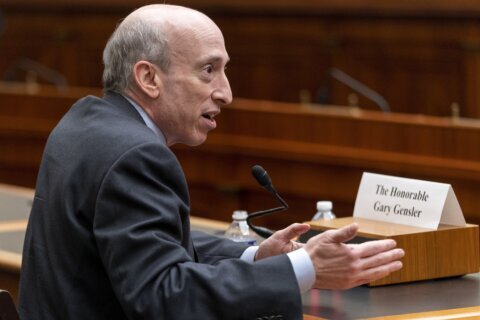ST. LOUIS (AP) — The Environmental Protection Agency distributed about $3 billion to states last year to replace harmful lead pipes based on unverified data, according to an agency inspector general’s memo, likely meaning some states got too much money and others got too little.
Investigators found two states had submitted inaccurate data, the memo dated Wednesday said. It didn’t name the states. The EPA has since made changes, but the inspector general said the agency could do more.
“Insufficient internal controls for verifying data led to allotments that did not represent the needs of each state, and if left unaddressed, the Agency runs the risk of using unreliable data for future” infrastructure spending, said EPA Inspector General Sean W. O’Donnell.
The agency said it disagrees with several aspects of the inspector general’s memo, saying its estimate of lead pipes is the best available and the right way to allocate funding to states. The agency also said it has safe guards in place to ensure money is spent correctly.
The Bipartisan Infrastructure Law provided $15 billion to find and replace lead pipes over five years. These pipes are especially common in the Midwest and Northeast and are typically found in older homes. Lead can reduce IQ scores in children and stunt their development. It is also linked to higher blood pressure in adults.
To distribute funds based on how many lead pipes states had, the EPA asked for estimates from states and utilities. Then, in April 2023, the agency announced the results — there are about 9.2 million lead pipes nationwide — and adjusted its funding formula.
Tom Neltner, national director with Unleaded Kids, said two states — Texas and Florida — had much higher totals than expected in those estimates. Florida ultimately received the most funding of any state in 2023: $254.8 million after an initial estimate of nearly 1.2 million lead pipes.
“By submitting inflated information, it takes money away from states that really need it,” he said.
Texas and Florida didn’t immediately respond to messages left with their governor’s offices and Florida’s Department of Environmental Quality.
The Biden administration has prioritized delivering safe drinking water to everyone. Earlier this year, the EPA proposed a rule that would require most cities and towns to replace all their lead pipes within a decade. It has also put limits on so-called “forever chemicals” in drinking water.
Republicans have repeatedly attacked the Biden administration’s spending on climate and environmental priorities as a handout to left-wing causes without enough accountability.
The EPA’s office of inspector general is in the middle of evaluating federal funding for lead pipe replacement, and had been in contact with agency officials earlier about some of their concerns. The inspector general expects to release a final report in the fall when it will identify each states’ inaccuracies.
The inspector general found a water provider in one state sent bad information to the agency and “adjustments made by another state” were also submitted.
The agency said it “performed a tremendous amount of quality assurance” work, disagreeing with the inspector general’s assertions that their efforts fell short. Federal officials reviewed local lead pipe estimates, rejecting some they found inadequate.
Even before the inspector general’s memo was released, some states had already complained to the EPA that its funding decisions weren’t fair.
“We have serious concerns about the quality of the data upon which EPA relied,” a February letter to the EPA from Massachusetts officials said.
In early May, the EPA adjusted its allocation of funds for 2024, which is based on some new information it received from utilities. President Biden announced the funding at a stop in Wilmington, North Carolina. Funding for Texas dropped the most; its $146.2 million was cut by about $117.6 million. Florida had the second-biggest reduction, cut by $26.1 million. Eight other states or territories saw smaller reductions.
Nineteen states got more money, led by Minnesota with $48.7 million more and New Jersey’s $40.1 million more.
Neltner said EPA deserves credit for collecting additional information to improve the accuracy of the funding granted.
The $15 billion is only a fraction of the total amount needed to replace all of the country’s lead pipes. Erik Olson, a health and food expert at the environmental group Natural Resources Defense Council, said inflated estimates by some states can direct a lot of money to the wrong place.
“I’ll just say it is suspicious,” he said.
Olson said it’s the obligation of water utilities and states to submit accurate information. But EPA deserves some blame, too, “for not verifying some of these numbers,” he said.
When the agency started distributing money, some states like Michigan had a long list of projects they wanted to fund. Others aren’t so far along and must first spend the money on inventories to find their lead pipes. A small number of states even declined funding in the first year it was offered.
If states don’t spend all of their money, it gets reallocated to states that need it more.
Neltner worries that if states receive more money than they need, they’ll spend it on expensive lead pipe inventories, not replacement efforts.
John Rumpler, clean water director with environmental group Environment America, said the important question is how well states are using the money they are given to replace lead pipes.
“Even if all of this money was perfectly allocated,” he said. “It would not remove all the lead pipes.”
___
Associated Press data journalist Mary Katherine Wildeman contributed reporting from Hartford, Connecticut.
___
The Associated Press receives support from the Walton Family Foundation for coverage of water and environmental policy. The AP is solely responsible for all content. For all of AP’s environmental coverage, visit https://apnews.com/hub/climate-and-environment
Copyright © 2024 The Associated Press. All rights reserved. This material may not be published, broadcast, written or redistributed.






